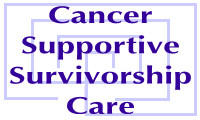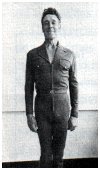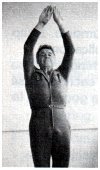|
Fifth Dimension Catalog Contact Us |
|

|
Exercises for Cancer Supportive Care |
The benefits of exercise in cancer prevention and treatment in the medical literature have documented causal relationships between exercise and prevention and exercise and quality of life issues. However, specific dosage for exercise programs have yet to be established. Some guidelines based on research in non-clinical populations offer clues for these exercise programs. For example, detrimental effects on the immune systems in athletes provide the common-sense suggestion that the cancer population exercise at levels that are moderate, not intense. The National Institute of Health (NIH) has recommended a program of moderate exercise, which includes such activities as walking, climbing stairs, and gardening, playing with children for non-clinical populations. These activities should be performed 6 - 7 days per week and can occur in 3 ten-minute sessions. The same moderate prescription is recommended for cancer patients.
The American College of Sports Medicine (ACSM) recommends for cancer patients undergoing treatment exercise programs that help patients meet the goal of maintaining cardiovascular endurance, muscular strength and level of functioning. Scientific research has documented that walking or bicycling 30 - 45 minutes per session, 3 - 5 days per week produces the following benefits: decreased nausea, decreased fatigue, increased physical endurance and increased quality of life. The benefits are believed to come from effects on hormone levels, adiposity, gut transport time, and endorphins produced by exercise that are believed to affect mood. Various types of aerobic and resistive exercises also improve the functioning of the heart/lung/circulation (cardiovascular system) and strength of the muscles. Aerobic exercise programs have added benefit of increasing the red blood cell count positively affecting the fatigue suffered by cancer patients undergoing treatment. While receiving the various cancer therapies, minimizing deconditioning of the body is the main goal of exercise program. The better condition you can maintain your body, the better you will tolerate the side effects of chemotherapy, radiation and other invasive treatments. It will also be easier to do the required activities of daily living
If you have been inactive for a long period of time, your muscles will begin to atrophy; that is, they will shrink in size and strength. Having an arm or leg in a cast demonstrates this process well. The longer you lie in bed or sit in a chair, the longer it will take you to regain your normal muscle strength and return to more active living. But you can start an exercise program that will build your muscle tone and stamina, no matter how limited your present physical condition.
Such an exercise program introduces activities gradually, starting first with passive and gentle limbering exercises. Even though the first series are done in bed, they will minimize joint and muscle deterioration, and will possibly prevent complications such as bone softening, blood clots, or even bedsores.
From this low energy program, you progress to sitting exercises which work against greater resistance, to build muscle tone. At this point you will be concentrating on the walking muscles. As you begin to spend a greater part of the day up and around, more active and vigorous exercises are brought into the program.
Exercising is enjoyable and can relieve the boredom and depression that often follows an extended stay in the hospital or confinement at home. Family and friends should be encouraged to learn the exercises with you. Exercising together, you will be more likely to stick to your program, and will feel more a part of the family again. Your companions will also get the satisfaction of directly participating, and helping you to return to more active living.
An important additional reason for their participation is safety. In the beginning, you may feel unsure of your ability to exercise, and may need them to help you into a comfortable position to start your exercises. They should be present, too, when you begin sitting or standing exercises, as you may feel dizzy when standing or bending over after a period of prolonged bed rest.
You may think that all useful exercises must be a part of a structured program which you do in one place at one time. While this may be true at first, later programs can use household chores, gardening, and sports activities as a means of exercising specific parts of the body. The more structured exercises can be done to prerecorded music and instructions. This helps organize and direct your daily exercise program, and makes it more pleasurable.
If you are recovering from a mastectomy, amputation, or other serious operation, special exercises would be added to the program, and alterations made where necessary.
Rules and Precautions for Safe Exercise
- When you begin, you will want to make sure that you do not get too tired or hurt yourself. To help you, we've listed a few simple rules:
-
1. Ask your physician if you are ready to exercise. At first, it is wise to let your doctor set the limits on your physical activity.
2. Have someone join you in doing the exercises-for enjoyment and for safety. This is especially important when you are just beginning to get out of bed, since you may get dizzy when standing up or bending over. 3. If you get tired or if your muscles feel sore, stop and rest.
4. Leave out exercises that seem too difficult. Try them another day when you feel stronger. If you have just had surgery, do not do any exercises using resistance unless you have okayed this with your doctor.
5. Try to repeat each exercise three to five times at first. If you feel too weak, do each only once or twice. Gradually increase the number to ten or twenty.
6. Try to exercise twice a day, and more often if you feel like it. - Do not exercise if blood counts are any of the following
- A. Abnormal levels of sodium and potassium (electrolytes)
B. Abnormal protein - Numbness in legs, hands (Oncvin, Velban, Vincristine, Vinblastine, Platinol, Taxol, Taxotere, Euflex)
Alternately contract, relax limbs
Avoid excessive weight-bearing-alternate walking with cycling- avoid uneven surfaces
- Infection, anemia, low blood pressure, bleeding (possibly due to abnormal blood count and plasma volume - all chemo drugs)
- A. Identify nadir period (7-12 days post chemo) avoid public swimming during this time
B. Check lab values
C. Drink lots of fluids - Cardiac Problems ( Doxorubicin, Cerubidine, Idamycin, Vovantron, Pharmarubicin)
- Best if EKG, blood pressure monitored
Watch for swollen ankles, shortness of breath and consult physician - Bone Weakening (long term Prednisone)
- Do strength training with resistive bands - no heavy weights! Be careful when walking.
- Other
- A. Pulmonary tumors - watch for shortness of breath
B. Neck, back pain should be evaluated for spinal cord compression or bowel obstruction
One of the key elements of any exercise program is to learn proper breathing techniques. Breathing, by itself, is a good exercise because it is both therapeutic and relaxing. The most important thing to remember is not to hold your breath while exercising. This puts an added strain on the heart, and could even cause you to faint. Breathe in or blow out in rhythm with every exercise activity.
- Here are two exercises that help promote breathing and relaxation:
-
Slow deep breaths. Breathe in for a count of four seconds and breathe out for a count of eight seconds. When your capacity improves, you may be able to breathe in for a count of 10 seconds and out for 20 seconds.
Short, fast deep breaths. This exercise helps you learn the rhythm of using your diaphragm instead of your rib muscles to breathe with. Concentrate on pushing the air out through your nose from the diaphragm, and then relax and allow your lungs to fill back up with air, making sure that your belly expands at the same time. Aim for a rate of one push every second.
|
Deep-Breathing Exercise The following deep-breathing exercise may be done standing up or sitting down.
1. Leave your arms at your sides, keeping your hands loose. 2. Slowly take in a deep breath through your nose while raising your arms over your head. 3. Slowly breathe out through your mouth while bringing your arms back down to your sides. |
|
||
|
Breathing Blow Bottle (Incentive Spirometer) The following exercise uses a breathing blow bottle (also called a breathing incentive spirometer) to increase your lung capacity and help avoid pulmonary complications. If you do not breathe deeply, especially after being on your back for prolonged intervals, you become increasingly susceptible to bronchitis and pneumonia, because fluid tends to collect in the lungs. Coughing is also good for you; take a deep breath and cough three to five times to clear your lungs. |
|||
- Increasing Lung Expansion
-
1. Blow out your breath(exhale).
2. Inhale through the breathing tube, causing the ball to rise as high as possible.
3. Repeat steps 1 and 2 from 5 to 10 times.
-
Begin each exercise session with a warm up. The idea of the warms up is to start moving slowly and gradually increase the blood flow to the muscles to prepare them for further work. Begin with taking a resting heart rate. If your rate is above 100 beats per minute, do not exercise unless check with MD. The warm-up should be sustained for 2-3 minutes and elevate the heart rate 10 - 20 beats above resting. This should correspond with an RPE score of 8 - 9 (see RPE explanation and chart below). Three to five minutes of stretching should follow.
Suggested movements include: More Suggetions Stage 1: Beginning To Move Exercises
- Shoulder shrugs
Alternate shoulder rolls
Wrist rolls
Alternate opening and closing of the hands
Arm lifts to the side, front and back
Elbow bends which bring hands up to shoulder (biceps curls)
Alternate arms to ceiling
Double arm reaches to ceiling followed by pull downs
Add toe taps, heel touches, small knee lifts, marching, side stepping.
- More Suggestions
-
Stage 1: Beginning To Move Exercises
Stage II: Increasing Physical Activity
Stage III: Up And Around
- Following the warm-up, begin your aerobic exercise of choice. The duration and intensity of the conditioning portion of the exercise session is based upon the patient's functional status. Please refer to the following Karnofsky Performance Scale (KPS) to determine the appropriate status.
Instructions for Borg Rating of Perceived Exertion (RPE) Scale
- Pay attention to the cues your body gives you such as breathing rate, how fast your heart is beating, fatigue in your working muscles. Take all cues into consideration and assign a number as to how hard the work feels. For example, 6 would be how you might feel sitting comfortably in a chair and resting. Above 18 would be working so hard physically that you couldn't continue for more than several seconds.
- 6 No exertion at all
7 Extremely light (7.5) 8
9 Very light
10
11 Light
12
13 Somewhat hard
14
15 Hard (heavy)
16
17 Very hard
18
19 Extremely hard
20 Maximal exertion - 9 corresponds to very light exercise. For a healthy person, it is like walking slowly at his or her own pace for some minutes
13 on the scale is somewhat hard exercise, but it still feels OK to continue.
17 very hard is very strenuous. A healthy person can still go on, but he or she really has to push him- or herself. It feels very heavy, and the person is very tired.
19 on the scale is an extremely strenuous exercise level. For most people this is the most strenuous exercise they have ever experienced. - ©Borg RPE scale --Gunnar Borg, 1970, 1985, 1994, 1998
Karnofsky Performance Scale (KPS)
- We use this scale to determine level of exercise
- 100% No evidence of disease
90% Normal activity with minor signs of disease
80% Normal activity with effort: signs of disease
70% Cannot do normal activity, but cares for self
60% Requires occasional assistance
50% Requires considerable assistance and frequent medical care
40% Disabled: requires special care
30% Severely disabled; hospitalization may be indicated
20% Very sick; hospitalization necessary for supportive treatment
10% Moribund - Karnofsky DA, Burchenal JH. (1949). "The Clinical Evaluation of Chemotherapeutic Agents in Cancer." In: MacLeod CM (Ed), Evaluation of Chemotherapeutic Agents. Columbia Univ Press. Page 196.
Aerobic Exercise Recommendations
Aerobic exercise is exercise that rhythmically uses the large muscles of the legs and arms to elevate the heart rate within a certain range. Examples are brisk walking, jogging, swimming, bicycling, gardening, dancing, playing actively with children, and sexual activity.
- Recommendations for Aerobic Programs
- 1) Those with Karnofsky scores of 70-100% can begin with 15 minutes of conditioning and increase the time by 1-2 minutes each session until a total of 40 minutes per session is achieved. Try to exercise 5 days per week. The conditioning portion of the exercise session should be intense enough to elevate the heart rate between 60 - 80% of the maximal heart rate as estimated by a treadmill test. For those who have not had a treadmill test, use the following formula to predict your maximal heart rate(MHR): 220 minus your age. Begin your program working at the low end of your MHR (60%) and as you become more fit increase the intensity of exercise by walking faster, gardening more vigorously, moving your arms more, etc, until you are working at 80% of your MHR. The time it takes to become conditioned enough to be comfortable exercising for 40 minutes at a higher heart rate varies with each individual, but a reasonable goal is eight weeks.
2) Those with a Karnofsky score of 50 - 70% can begin with five minutes of exercise at 55% of MHR three times per day, adding one minute to each interval each time until ten minute intervals are achieved. Follow this program 6-7 days per week. Then reduce the number of intervals to two, adding one minute each time until fifteen minutes are achieved. At that time, exercise once a day, adding on a minute each day and following the program prescribed for Karnofsky 70-100% as explained in the beginning of this paragraph. In addition to determining your exercise intensity by taking your heart rate, use the RPE scale. Your RPE for the conditioning phase should be 11-14. Note: Those who are taking certain blood pressure medicines may not be able to elevate their heart rate and may have to use the RPE scale exclusively for determining appropriate work levels. Check with your physician to find out if your medications blunt your heart rate.
Yoga can help a person react to potentially stressful situations in beneficial ways by counteracting many of the body's natural responses to stress.
Many of the yoga practices activate the parasympathetic nervous system to bring relaxation and restoration to the body by stabilizing blood pressure, lowering heart rate and the body's demand for oxygen, slowing breath rate, increasing lung capacity, improving digestion, increasing feelings of calm and tranquility and bringing about a measurable improvements in the immune system. In a yoga class designed especially for cancer patients, students are encouraged to gently extend their awareness of their physical, emotional, sensory and thinking levels. They practice a slow, deliberate yoga adapted to their own needs and physical limitations. Attention to breathing and a focused awareness of the movements and the stillness of each yoga pose characterize this particular style of yoga.
As the body gains flexibility and the breath deepens, the mind and emotions settle into greater ease and balance. In quiet times of deep relaxation and meditation, habituated patterns of thinking and behaving may become more obvious and lend themselves to change. Yoga practices include yoga postures and stretches, breathing practices, imagery, meditation and progressive relaxation. While each technique has its own specific purposes, all have the common aim of helping to develop a focused awareness of what is happening in the body and mind--emotionally, physically and spiritually.
|
You are welcome to share this © article with friends, but do not forget to include the author name and web address. Permission needed to use articles on commercial and non commercial websites. Thank you. |

